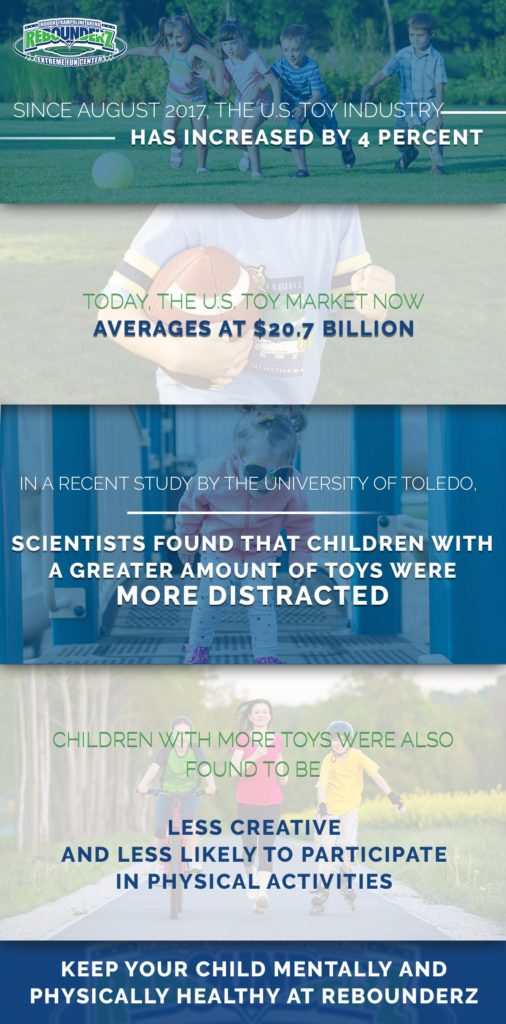ENJOY FREE ADMISSION EVERY DAY WHEN YOU PURCHASE A REBOUNDERZ MEMBERSHIP!

Call Us Now: (833) 832-1255
ENJOY FREE ADMISSION EVERY DAY WHEN YOU PURCHASE A REBOUNDERZ MEMBERSHIP!

Call Us Now: (833) 832-1255


Almost all children in America have at least one toy. For some, a closet full of them. Despite the belief that electronics would take over children’s main form of entertainment, this is not true. Children still have a strong affinity for toys and ask their parents purchase them often. In fact, the toy industry produces billions in revenue each year. Top companies, such as Mattel and Lego both rake in more than $5 billion each. With that much money being made, you have to wonder, is the toy market growing too large? And, what are the effects on children? Since August 2017, the toy industry has increased by 4 percent. Which this can be surprising after the major toy distributor, Toys R Us, officially closed their doors due to bankruptcy. In this blog, we will discuss the increase in the toy industry, the fall of a major business, and how this erupting toy market could affect your children.
Though the onset of electronics for children has grown, toys now more than ever have entertainment value. In the United States, in just the short few months of 2018, the toy market has grown by 1 percent. Though this number may not seem consequential, in fact this small percentage equates to millions of dollars. But, despite the increase in the U.S toy market, the rest of the world is also changing in terms of the toy market. Countries like Mexico and Russia have increased their markets by more than 10 percent. With 12 main global markets increasing toy production and toy sales, the world’s toy market now averages at $99 billion. As this is such a large market, affecting roughly a billion children, it begs the question, what toys are selling? And, what are the effects of the toys on the children they are being sold to?
In a report by the NPD Group, it was confirmed that in 2017, fidget toys, plush items, and dolls controlled the market of toys, each growing their perspective markets by several percentage points. In terms of the global toy markets, the same three major toy manufacturers top the charts across the board: Nerf, Star Wars merchandise, and Barbie. In the United States, Nerf took the top spot, followed by Star Wars, and then Barbie products. The possible sway towards Nerf, is perhaps that not just kids are purchasing these toys. In fact, some of the market is earned by adults purchasing these product for themselves.
It was confirmed by an analysts at The NPD Group that, “The toy industry’s 2017 success was tied to consumers positively reacting to social media driven trends and lower price points.” Due to the decrease in prices of toys and the push through social media advertisements and trends, toys are more easily sold. Children are strongly influenced by the ads and trends they see on social media platforms, such as Twitter, Instagram, and Facebook. Companies will devote their marketing budgets to social media ads, as a way to popularize their items never before seen. Agencies have even been hired to seek out trends and conduct focus groups in order to figure out what consumers are interested in now, and what they will want in the future. The same is no different for the toy industry, focus groups are conducted in order to figure out which toy will be more desirable to children.
With that being said, toy manufacturers must also be attuned to the minds of the children’s parents as well. For example, the Mattel and MGA companies were under fire back in the early 2000s for not demonstrating what girls should look like or aspire to — the Mattel Corporation owns Barbie products, while MGA Company owns Bratz dolls. Since the 1960s Barbie, and later, Bratz, has been criticised by not portraying women and young girls as independent, strong, and authentic people. For instance, Barbie products have always been portrayed as unrealistically thin, with a long torso and a long neck. At the same time, Bratz has been sued for not only copying Barbie’s form design, but portraying women as ultra thin and warp-headed, with heavy makeup and pouty lips. Mattel sued MGA for stealing their vision for a girls toy and criticized the “near-pornographic style” in which they design their dolls. In 2013 the case was concluded, stating that Barbie and Bratz are owned by two seperate companies, and that neither stole any ideas from the other. However, though the case had closed, that did not mean troubles were over for both companies. After Facebook’s Sheryl Sandberg published her novel Lean In and parents were outraged by their children’s dolls being portrayed as “shopping-crazed and dumb,” both companies made a change. Advertising campaigns for both companies were installed in order to reinforce the idea of women empowerment in the job market. Though the companies were agile and adjusted the way in which they marketed, the toy market has seen great changes since the advent of the computer and social media.
Aside from changing the way in which toys are advertised, the internet has also changed the way in which toys are purchased. Major corporations such as Toys R Us recently had to file bankruptcy. The advent of the .com changed the way toys were sold; instead of going to a store, you can easily purchase and ship a toy with a few clicks. Because of the ease of online purchasing, Toys R Us was not able to keep up with its major competitor. But, what does this mean for the toy industry? Well, nothing actually. The industry has been booming, despite the mass toy store shut down. Many people have some sort of electronic device and since smart phones allow for internet access almost anywhere, parents are able to purchase toys on the go and at a whim.
Does this sudden boom in the toy industry signify something darker? In a study performed at the University of Toledo, it was revealed that children with too many toys were more easily distracted and were not able to benefit in quality playtime. Using 36 toddlers, scientists concluded that children were far more creative with fewer toys to play with. Also, a fewer number of toys suggested that children would be more inclined to engage in other activities, such as reading, painting, or other physical activities. A main worry with the incline of toys is that this may sway children to play more indoors. Today, there is already an issue with childhood obesity and children not getting enough exercise. The concern amongst some parents is that this incline in toy purchases will result in children becoming more distracted, less creative, and indoor-inclined.
The concern is not whether the children indoors is the problem, it is that children aren’t getting enough exercise. For a parent, the best way to combat this problem is by coming up with ways to encourage your child’s physical activity. Rebounderz indoor trampoline parks offer every child a fun space to run, jump, and climb to their heart’s content. If you are interested in keeping your child mentally and physically healthy, taking them to Rebounderz is a great resource. Visit us today!